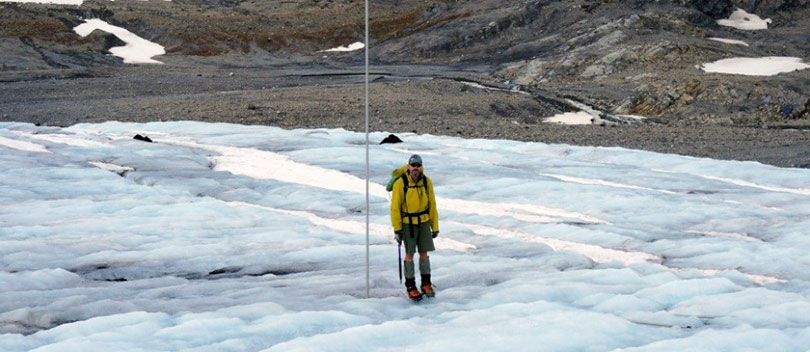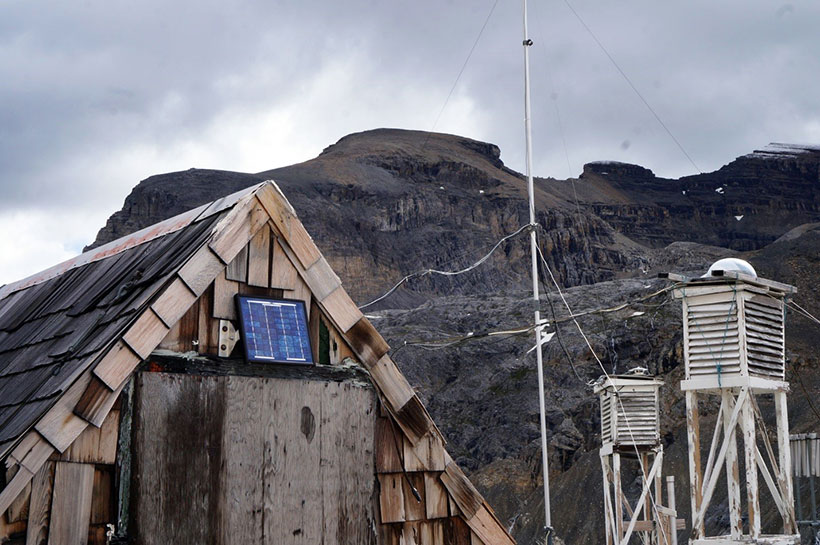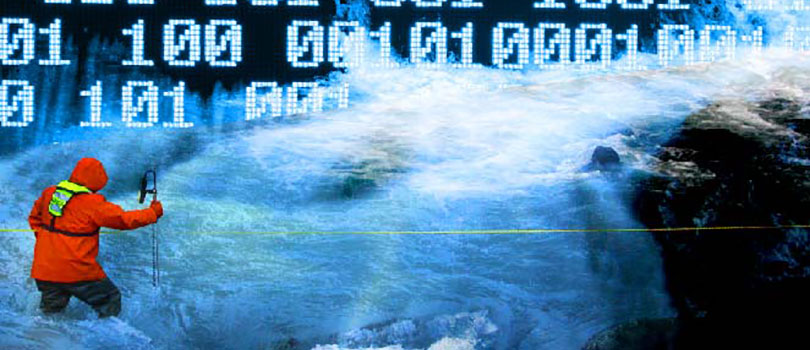
A Hydrologist’s Holiday
Stu Hamilton next to an ablation stake on the Peyto Glacer. Note the meltwater channels eroded into the ice surface. When the sun hits the ice later in the day these channels will be running full of water and draining down crevasses contributing to sub-glacial flow. Sub-glacial flow is linked with glacier thinning. Photo by Ian Hamilton, July 20, 2014
A 3-day hike in July on the Wapta Icefield in the Canadian Rockies with my son took us up the Bow Glacier, briefly onto the Yoho Glacier and then down the Peyto Glacier. Bow Glacier meltwater flows into the South Saskatchewan River (146,100 km2). Yoho Glacier meltwater flows into the Columbia River (668,000 km2). Peyto Glacier meltwater flows in the North Saskatchewan River (122,800 km2).
The importance of glacial meltwater to the Canadian and American economies cannot be over-stated.
Meltwater cools salmon-bearing streams enabling salmon to migrate far inland without suffering from heat exhaustion. The late-summer timing of meltwater is ideal for irrigating a vast area of fertile soils in the Great Plains. The potential energy of this high elevation water store is recovered to generate massive amounts of hydro power. There are 14 dams on the main stem of the Columbia River alone. The Saskatchewan River is a major source of water for the Nelson River Hydroelectric Project.
I have not been on the Wapta before but anticipated that in mid-July, most of the hike would be on firn. Firn is very dense old snow covering the glacier ice after the previous winters snow has melted. Instead I was saddened to see how much of the glacier ice is already exposed to the sun with a good two months of the melt season yet to come.
The current state of these glaciers is mindful of visiting a close relative of some of my favorite landscapes in a palliative care ward. Early season bare ice patches are like cancerous lesions to a glacier. The only effective treatment for bare patches is snow, and lots of it.
The glacier needs snow like my nose needs sunscreen.
The best is first year snow, fresh and bright. The albedo of new snow reflects upwards of 80% of the sun’s energy back into the atmosphere. The firn we were walking across at higher elevations was dirty from previous seasons exposure exacerbated by soot from large forest fires in the area reducing the albedo to, perhaps, 50%. The exposed dirty bare ice was probably absorbing upwards of 70% of the sun’s energy rapidly turning the glacial surface to slush and meltwater rivulets.
The first records of the Peyto glacier date back to photographs taken in 1896. Glacial recession was monitored from 1945 to 1962. In 1965, the Peyto Glacier was selected for study as part of the International Hydrological Decade (IHD). Research has shown that the health of the glacier is indicated by the elevation of the transient snowline and that the net mass balance is almost entirely related to summer temperature.
Peyto Glacier is estimated to have lost 1.1 cubic kilometers of its volume between 1896 and 1966 (15,600,000 m3/year). This rapid rate of recession pre-dates the modern era of CO2 induced climate change. I anticipate that recent data (as yet unpublished) will indicate a substantially increased rate of melt.
Glacial ice is ancient water, perhaps thousands of years old.
The loss of these stores is as significant and important an issue as over-use of the great aquifers of the world. We may be powerless to alter the rate of loss but it seems odd that there is no public outrage at the state of our investment in monitoring of change in an asset that we are all so dependent on.
Thank goodness for our dedicated glaciologists who are struggling to hold a sparse program together on a shoestring budget.

View of the Peyto Glacier from the Glaciology station. The skyline marks the Continental Divide. A precipitation gauge is shown in the foreground. The approximate position of the ablation stake is indicated. Note the extent of ice that is unprotected from the sun by snow cover. Photo by Ian Hamilton, July 20, 2014

The shabbiness of the Peyto Glaciology station reflects inadequate funding for glaciological research in Canada. The priceless data provided by this station is due to the passion of our glaciologists in spite of, rather than because of, their mandated resources. Photo by Ian Hamilton, July 20, 2014


